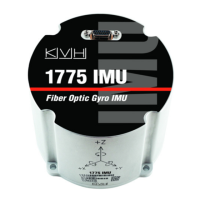This document contains proprietary information of KVH Industries, Inc. and neither this document nor said proprietary information shall be
published, reproduced, copied, disclosed, or used for any purpose without the express written permission of a duly authorized KVH representative.
Page 73 of 77
The intermediate sampling period latency associated with interpolation mentioned above will
depend on the system configuration.
If the system’s final output filter is disabled, then the intermediate sample period is
based on the internal highest data rate sample timing (20 KHz for 1775 IMU gyros,
8.3125 KHz for accelerometers).
If the system output filter is enabled (e.g., Uniform Averager, Chebyshev, Butterworth,
or custom) the intermediate output rate (i.e., final stage input sample rate) is
determined by the data rate configured. Therefore, the relative latencies will change
as well. Note: the Averager filter type is still subject to the downsampled time period
associated with the data rate configuration. In the case when using the Averager with
the external MSYNC mode, it may be useful to set the data rate to 100 Hz or above,
so the internal intermediate downsampling is set to 1:1 and the intermediate filtering is
minimized. The Averager can then operate at full speed.
Based on the interpolation scheme, data is output according to the following formula:
D_out = D1 * (1 - T2 / T1) + D2 * (T2 / T1)
where D1 is the prior internal data value and D2 is the most recent internal data value
As T2 shrinks toward 0, this results in more of the interpolated value being a result of D1 and
less of it being D2. Similarly, as T2 approaches T1, it uses more of D2 and less of D1. This
results in a linear interpolated value, with the compromise of adding one data cycle of
latency. The data cycle here would be based on the internal time tags of the D1 and D2
points.
Optimization of the calculation of the equation above is as follows:
D_out = D1 * (1 - T2 / T1) + D2 * (T2 / T1)
= D1 * ((T1 - T2) / T1) + D2 * (T2 / T1)
= (1 / T1) * (D1 * (T1 - T2) + D2 * T2)
= (1 / T1) * (D1 * T1 - D1 * T2 + D2 * T2)
= (1 / T1) * (D1 * T1 + (D2 - D1) * T2)
= D1 + (T2 / T1) * (D2 - D1)
Based on the final equation, we see this is simply the equation of a line in the equation
below:
m = (D2 - D1) / T1
x = T2
b = D1
12.2.8 Biquad Filtering (Additional Information)
A biquad filter stage is simply a two-pole infinite impulse response (IIR) filter, where both the
numerator and denominator are quadratic equations. The numerator coefficients, typically b
n
,
define the feedforward values. The denominator coefficients, typically a
n
, define the feedback

